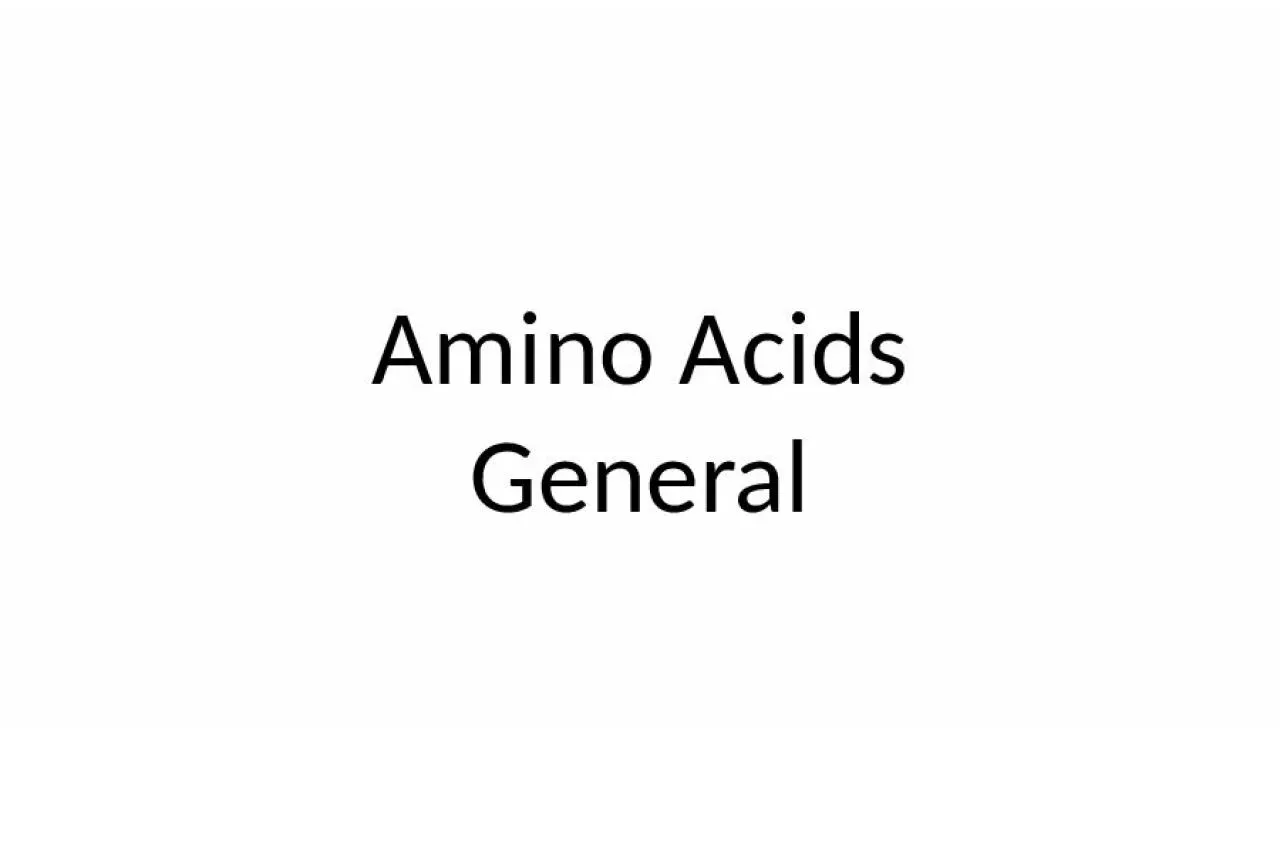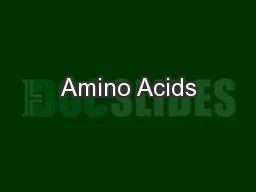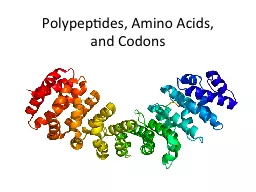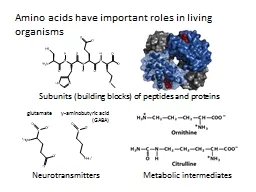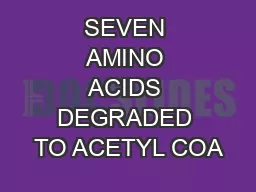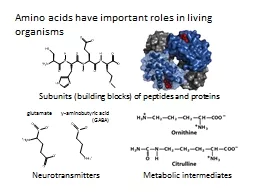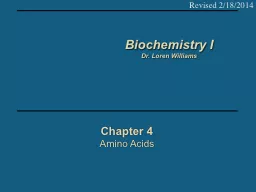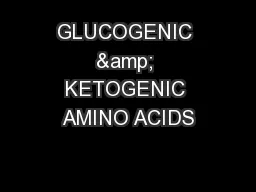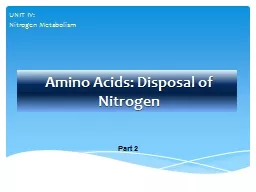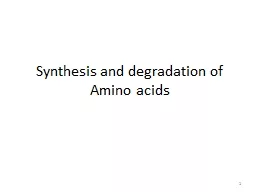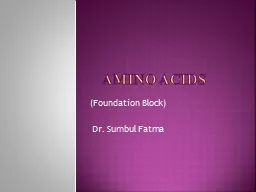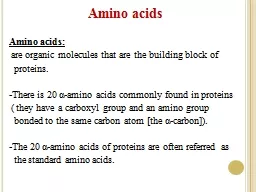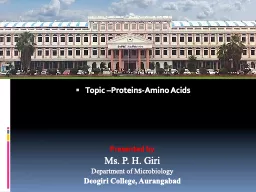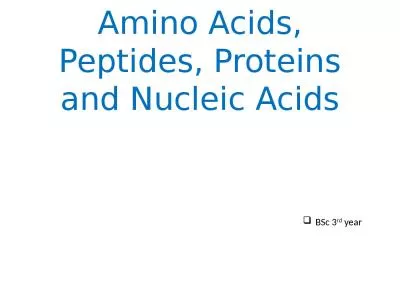PPT-Amino Acids General Amino Acids:
Author : CutiePie | Published Date : 2022-08-03
Building blocks for peptides proteins Some individually important or converted to important molecules Gly Glu Tyr neurotransmitters Tyr parentprecursor for
Presentation Embed Code
Download Presentation
Download Presentation The PPT/PDF document "Amino Acids General Amino Acids:" is the property of its rightful owner. Permission is granted to download and print the materials on this website for personal, non-commercial use only, and to display it on your personal computer provided you do not modify the materials and that you retain all copyright notices contained in the materials. By downloading content from our website, you accept the terms of this agreement.
Amino Acids General Amino Acids:: Transcript
Building blocks for peptides proteins Some individually important or converted to important molecules Gly Glu Tyr neurotransmitters Tyr parentprecursor for epinephrine adrenaline. What are amino acids?. Amino acids are the building blocks of proteins.. In the body, they exist as zwitterions.. Zwitterions can behave as both an acid or a base.. Today we will:. Study . the acid-base properties of amino acids, . C483 Spring 2013. Questions. 1. . Amino acids with non-. ionizable. side chains are zwitterions when they are ________.. A. ) in any solution . . D) in alkaline solutions only . B. ) at physiological pH, pH = 7.4 . Codons. Prefixes, Suffixes and Vocabulary. Poly. = many. Peptide bond . =bond between two amino acids.. Anti. = against, opposite. Dehydration. = loss of water. Polypeptide. = long assembled string of amino acids.. Subunits (building blocks) of peptides and proteins. Neurotransmitters. Metabolic intermediates. glutamate. γ. -. aminobutyric. acid. (GABA). Proteins are synthesized from 20 ‘standard’ . α. -amino acids. Their names have 3- and 1-letter abbreviations.. THE EXCRETION OF AMMONIUM IONS. A part of NH4+ that is formed in the degradation of amino acids is used for the biosynthesis of nitrogen compounds. In most of the land living vertebrates the excess NH4+ is converted in urea and in that form is excreted. In birds and reptiles it is converted into uric acid and in aquatic animals it is directly excreted as urea.. Subunits (building blocks) of peptides and proteins. Neurotransmitters. Metabolic intermediates. glutamate. γ. -. aminobutyric. acid. (GABA). Proteins are synthesized from 20 ‘standard’ . α. -amino acids. Their names have 3- and 1-letter abbreviations.. 18. /2014. Biochemistry I. Dr. Loren Williams. Proteinogenic Amino Acids. An amino acid contains . an amine group . a carboxylic acid group, . a side-chain (or R-group,. all attached to the same chiral carbon atom (the Cα). DR AMINA . BIOCHEMISTRY. All tissues have some capability for synthesis of:. The non-essential amino acids,. Amino acid remodeling, . and Conversion of non-amino acid carbon skeletons into amino acids and other derivatives that contain nitrogen. . UNIT IV:. Nitrogen Metabolism. Part 2. Most of the nitrogen in the diet is consumed in the form of protein, typically amounting to 70–100 g/day in the American diet . Proteins are generally too large to be absorbed by the intestine. . 1. . Overview. The catabolism of the amino acids involves:. Removal of α-amino groups. . Breakdown of the resulting carbon skeletons.. The resulting compounds will be used to form seven intermediate products: . ). Dr. . Sumbul. . Fatma. Learning outcomes. What are the amino acids?. General structure.. Classification of amino acids.. Optical properties.. Amino acid configuration.. Non-standard amino acids.. . are organic molecules that are the building block of . . proteins. .. -There is 20 . α. -amino acids commonly found in . proteins. . ( . they . have a carboxyl group and an amino group . . . Presented . by. Ms. . P. . . H. . Giri. Department of Microbiology. Deogiri . College, Aurangabad. B.Sc. F. Y.. Semester II. Paper No. V. Basic Biochemistry. Unit 3 Proteins. Ms. . Priyanka. H. . Giri. BSc 3. rd. year . AMINO ACIDS. C. lassification of amino acids . Classification according to nature of side chain. PREPARATION OF AMINO ACIDS. 1. Gabriel Phthalimide synthesis. 2. Strecker’s synthesis.
Download Rules Of Document
"Amino Acids General Amino Acids:"The content belongs to its owner. You may download and print it for personal use, without modification, and keep all copyright notices. By downloading, you agree to these terms.
Related Documents

